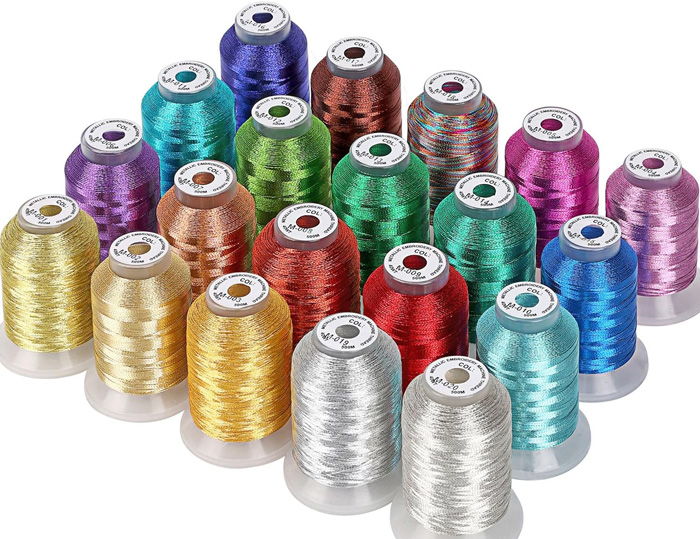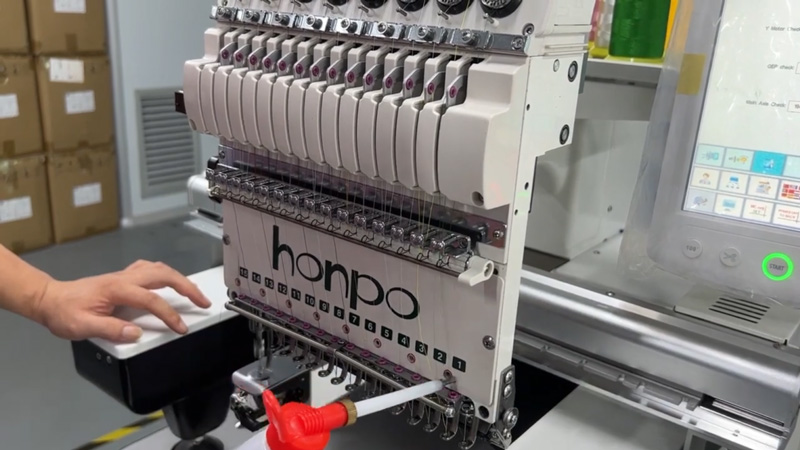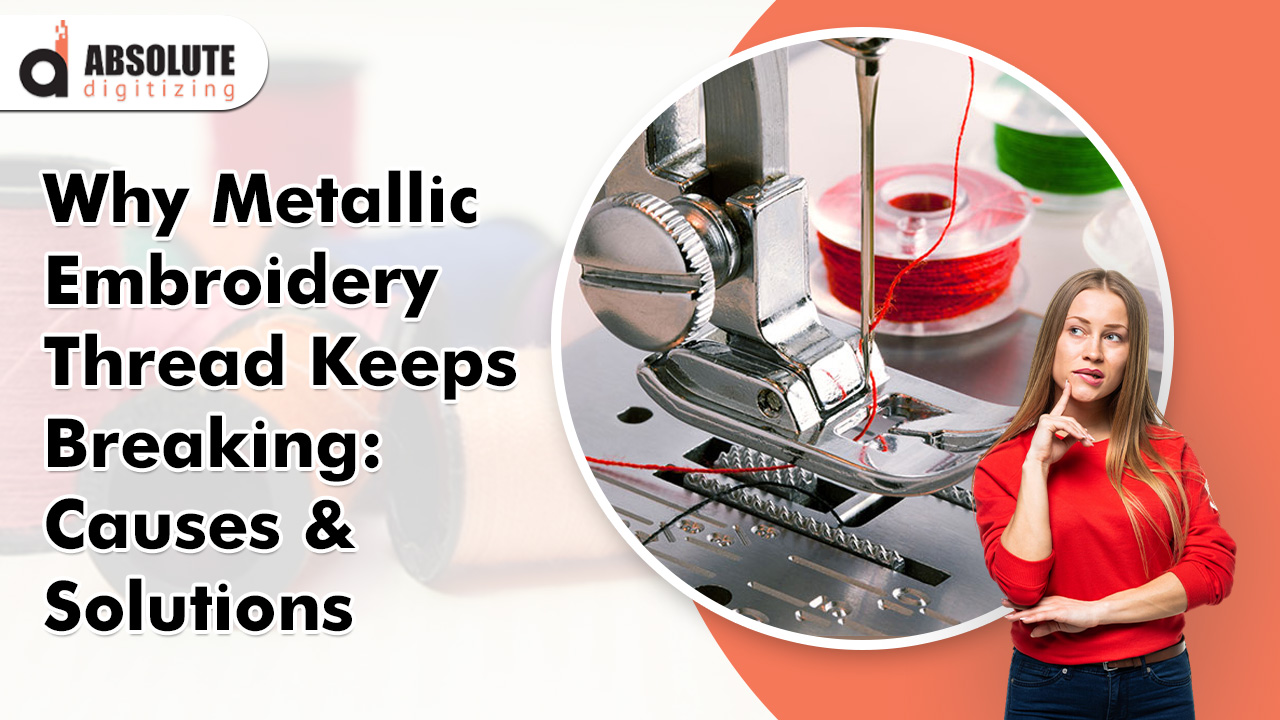Metallic embroidery threads add a shimmering elegance to designs, making them a favorite for many embroiderers. However, they can also be notoriously challenging to work with due to frequent breakage. Understanding why this happens and how to prevent it can save time, reduce frustration, and ensure your projects turn out beautifully. In this blog, we will explore common causes for metallic thread breakage and provide practical solutions to overcome these issues.

Common Causes of Metallic Thread Breakage
1. Thread Quality:
- Poor Quality Threads: Low-quality metallic threads are prone to fraying and breaking. Investing in high-quality threads from reputable brands can significantly reduce breakage.
- Thread Composition: Metallic threads are made of a core wrapped in a metallic foil. Inferior wrapping techniques can lead to uneven tension and breakage.
2. Machine Settings:
- High Speed: Embroidery machines running at high speeds exert more stress on the delicate metallic threads, causing them to snap.
- Incorrect Tension: Too much or too little tension can cause thread breakage. Proper tension adjustments are crucial.
3. Needles:
- Incorrect Needle Type: Using the wrong needle type or size can cause issues. Metallic needles, designed with larger eyes and smoother surfaces, reduce friction and breakage.
- Dull Needles: Old or dull needles can cause metallic threads to fray and break. Regularly changing needles ensures smoother stitching.
4. Thread Path:
- Improper Threading: Incorrect threading can increase tension and stress on the thread.
- Thread Guides and Spool Caps: Not using the right thread guides or spool caps can cause additional tension.
5. Fabric and Stabilizers:
- Inappropriate Fabric: Fabrics with rough textures or loose weaves can catch on metallic threads, leading to breakage.
- Lack of Stabilizers: Stabilizers provide the necessary support for delicate threads. The absence or incorrect use of stabilizers can cause thread issues.

Solutions to Prevent Metallic Thread Breakage
1. Invest in High-Quality Threads
Quality matters significantly when it comes to metallic threads. Choose brands known for their durability and smothness. High-quality threads may cost more but save time and frustration in the long run.
2. Adjust Machine Settings
- Speed: Slow down your machine. Metallic threads are delicate and perform better at lower speeds. Start at a speed of 300-600 stitches per minute and adjust as needed.
- Tension: Adjust the tension settings specifically for metallic threads. Lower the top tension to allow the thread to glide smoothly through the machine.
3. Use the Right Needle
- Needle Type: Use a metallic needle, which has a larger eye to accommodate the thicker thread and a special coating to reduce friction.
- Needle Size: A size 90/14 needle is generally recommended for metallic threads. This size helps to handle the thread’s bulk and reduces breakage.
4. Proper Threading and Handling
- Thread Path: Ensure the thread follows the correct path and is not twisted or caught on anything. Use a vertical spool pin to allow the thread to unwind smoothly.
- Thread Guides: Use thread nets or guides to keep the thread from tangling. A spool cap that fits the thread spool can also help maintain proper tension.
5. Choose the Right Fabric and Stabilizers
- Fabric: Opt for fabrics with a tight weave that won’t snag the thread. Test different fabrics to find the best match for your project.
- Stabilizers: Use appropriate stabilizers to support the fabric and thread. A cut-away or tear-away stabilizer can provide the necessary support, preventing puckering and thread breakage.
6. Lubrication
Lubricating the metallic thread can reduce friction and prevent breakage. Special silicone-based thread lubricants can be applied to the thread spool or needle. Be cautious with the amount used to avoid staining the fabric.

Additional Tips for Working with Metallic Threads
Thread Length: Avoid using long lengths of metallic thread. Shorter lengths reduce the chances of twisting and tangling.
Storage: Store metallic threads in a cool, dry place to prevent damage from moisture or heat.
Practice: Spend some time practicing with metallic threads on scrap fabric before starting your main project. This helps you get a feel for the thread’s behavior and make necessary adjustments.
Conclusion
Mastering the use of metallic embroidery threads can transform your projects with a touch of elegance and sparkle. While these threads can be challenging, understanding the causes of breakage and applying the right techniques can make the process smoother and more enjoyable. By investing in quality threads, adjusting your machine settings, using the correct needles, and choosing the right fabric and stabilizers, you can reduce frustration and achieve stunning results.
Remember, patience and practice are key. With these tips, you’ll be well-equipped to tackle any project with metallic embroidery threads, ensuring your designs shine brilliantly without the hassle of constant thread breakage.
Absolute Digitizing: Your Ultimate Embroidery Digitizing Partner
If you need professional digitizing services to bring your designs to life, Absolute Digitizing is here to help. We offer top-notch embroidery digitizing and vector art services to meet your needs. Enjoy a 50% discount for lifetime when you get started today. Contact us today to get a free quote within minutes. Happy stitching!
By understanding and implementing these strategies, you can master the art of using metallic embroidery threads, adding a new dimension of beauty to your creations. For more embroidery tips and high-quality digitizing services, visit Absolute Digitizing today!

